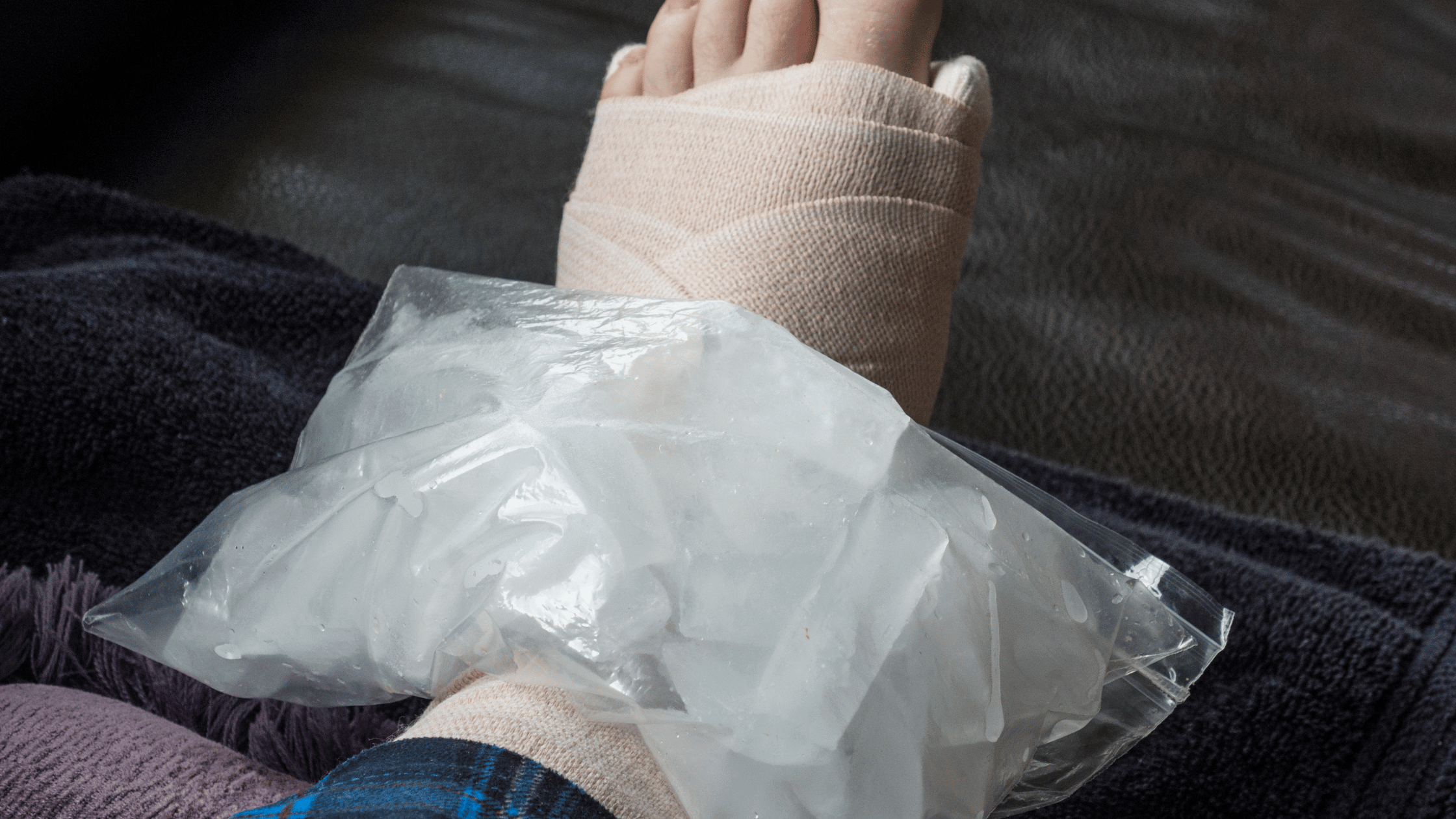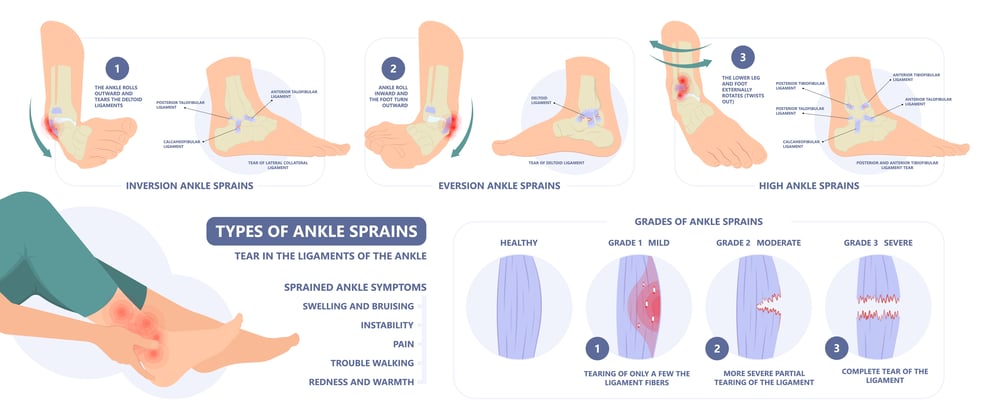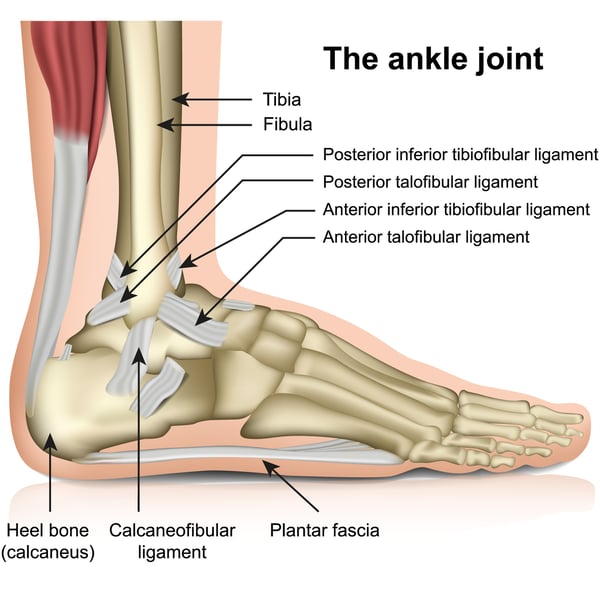Understanding Ankle Injuries: Causes, Severity, and Treatment Plans

Licensed Physical Therapist, PT, DPT // EW Motion Therapy Meadowbrook/280
Ankle injuries are common, affecting people of all ages and backgrounds. Whether you are an athlete, a weekend warrior, or simply going about your daily activities, understanding the various types of ankle injuries, their causes, levels of severity, and effective treatment plans is crucial for quick recovery and prevention of future injuries. Physical therapy is often an instrumental piece of a recovery plan - our ultimate goal is to help our clients at EW Motion Therapy recover and return to their favorite activities. But even if you decide that our physical therapy doesn’t fit your needs, you can still review this comprehensive guide as we delve into the most common ankle injuries, explore their causes, differentiate their severity, and outline the best treatment approaches.
Common ankle injuries and their causes
Sprains and strains
Ankle sprains are among the most prevalent injuries, occurring when the ligaments that support the ankle stretch beyond their limits or tear. These injuries often happen during physical activities and everyday movements.
Causes of ankle sprains
Sprains typically result from a sudden twist or turn of the foot, often occurring during sports activities or by stepping on an uneven surface. This abrupt movement can overextend or tear the ligaments, leading to a sprain.
Grades of severity
Ankle sprains are typically classified into three grades:
- Grade I (mild): Slight stretching and microscopic tearing of the ligament fibers.
- Grade II (moderate): Partial tearing of the ligament.
- Grade III (severe): Complete ligament tear.
High ankle sprain
A high ankle sprain is an injury to the ligaments that connect the lower leg bones (tibia and fibula) just above the ankle. This type of sprain often occurs from a forceful outward twisting of the foot, a common incident in various sports. Compared to regular ankle sprains that affect the ankle joint, high ankle sprains are more complex and typically require a longer recovery period.

Fractures
Ankle fractures involve a break in one or more bones that constitute the ankle joint. These injuries range from small cracks in the bone to complete breaks and can vary significantly in severity. Fractures can range from minor cracks to severe breaks. The severity is often determined by the number of bones broken, the location of the fracture, and whether the bone is displaced.
Types of ankle fractures
There are five distinct ankle fractures that can occur within the bones that make up the ankle joint. Let’s discuss each and where they happen.
- Lateral malleolus fracture: This is a fracture of the fibula, the smaller of the two leg bones, at the ankle level. It's the most frequently occurring type of ankle fracture.
- Medial malleolus fracture: This involves a tibia break at the ankle’s inner part.
- Bimalleolar fractures: These fractures involve both the medial and lateral malleoli, meaning there are breaks in both the tibia and fibula at the ankle level.
- Trimalleolar fracture: A severe injury involving the lateral malleolus, medial malleolus, and the posterior part of the tibia.
- Pilon fracture: This fracture occurs at the distal end of the tibia and impacts the ankle joint. It usually results from a high-impact injury.
Causes of fractures
Fractures usually result from high-impact injuries such as falls, car accidents, or sports injuries. They can also occur from overuse, where repeated stress on the ankle bone leads to a stress fracture.

Tendonitis and tendinosis
Tendon injuries, including tendonitis (inflammation of the tendon) and tendinosis (degeneration of the tendon), affect the tendons surrounding the ankle. Tendonitis is generally less severe and more responsive to treatment than tendinosis, which indicates a more chronic condition with tendon degeneration.
The most common tendons affected by tendonitis or tendinosis are as follows:
- Achilles tendon: This is the most common area for tendonitis in the ankle. The Achilles tendon connects the calf muscles to the heel bone. Overuse or strain can lead to inflammation in this tendon, causing pain and stiffness in the area.
- Posterior tibial tendon: This tendon runs inside the ankle and foot. Inflammation in this tendon can cause pain on the inside of the ankle and can lead to flatfoot if it becomes chronic.
- Peroneal tendons: These tendons run on the outside of the ankle. Tendonitis here can cause pain on the outer side of the ankle, often due to overuse or ankle sprains.
- Anterior tibial tendon: This tendon is located at the front of the ankle. Inflammation can cause pain and swelling in the front part of the ankle, especially when walking or running.
- Extensor tendons: These are located on the top of the foot and extend to the toes. Tendonitis in this area can cause pain and difficulty in lifting the toes.
Causes of tendon injuries
These are the most common causes of tendon injuries:
- Overuse and repetitive activity: Frequent and repetitive movements, particularly in sports or physical activities, can overstrain the tendons in the ankle, leading to tendonitis. This is common in runners, dancers, and athletes in sports that involve jumping or rapid changes in direction.
- Injury or trauma: Sudden injuries, such as ankle sprains or strains, can damage the tendons around the ankle, leading to inflammation and tendonitis.
- Improper footwear: Wearing shoes that do not provide adequate support or are unsuitable for a specific activity can strain the ankle tendons.
- Poor training techniques: Incorrect training methods or rapidly increasing the intensity or duration of physical activities without proper conditioning can lead to tendon overuse and inflammation.
- Age-related wear and tear: As people age, tendons can lose their elasticity and become more susceptible to injury, leading to tendonitis.
- Biomechanical issues: Problems with foot and ankle alignment, such as flat feet or high arches, can put additional stress on the tendons.
- Arthritis and inflammatory diseases: Conditions like rheumatoid arthritis or gout can cause inflammation in the joints and tendons, leading to tendonitis.
- Being overweight: Extra weight can put more strain on the tendons in the ankle, increasing the risk of tendonitis.
It's important to address these factors, especially in the context of sports and physical activities, to prevent the development of tendonitis. If symptoms of tendonitis arise, seeking prompt medical advice is recommended to manage the condition effectively.
Best treatment plans for ankle injuries
Immediate care: RICE method
The RICE method (Rest, Ice, Compression, Elevation) is a universally recommended first-line treatment for most ankle injuries, particularly right after the injury occurs.
Rest and ice
Limiting movement and applying ice helps reduce swelling and pain. Ice should be used for about 20 minutes every few hours during the first 48 hours. Additionally, using a compression bandage and keeping the ankle above heart level helps minimize swelling and bruising.
Physical therapy and rehabilitation
Physical therapy plays a crucial role in the recovery process, particularly for moderate to severe injuries. A physical therapist can design a personalized rehabilitation program to restore range of motion, strength, and balance.
- Strengthening exercises: Exercises targeting the muscles around the ankle improve stability and prevent future injuries.
- Flexibility exercises: Stretching exercises enhance flexibility, reducing the risk of ligament and tendon injuries.
- Medical intervention: In cases of severe fractures or complete ligament tears, medical intervention may be necessary.
- Surgery: Surgery may be required to repair severely damaged ligaments or to set and stabilize broken bones.
- Medication: Pain relief and anti-inflammatory medications can help manage pain and reduce swelling.
- Prevention strategies: Preventive measures are vital in avoiding ankle injuries. These include proper footwear, gradually increasing activity, and incorporating balance and strength training into your routine.
- Footwear: Wearing supportive shoes that fit well can significantly reduce the risk of ankle injuries.
- Training and conditioning: Regular strength and flexibility exercises strengthen the ankle and improve proprioception, reducing the risk of injury.
Ankle injuries, though common, can be effectively managed and prevented with the proper knowledge and approach. Understanding the causes, recognizing the levels of severity, and implementing the best treatment plans are crucial for a swift recovery and a return to pain-free activity. Remember, it's always advisable to consult a healthcare professional for a proper diagnosis and personalized treatment plan. We help our clients at EW Motion Therapy stay informed, stay active, and take proactive steps to maintain their overall well-being. If you’re curious about how else physical therapy can help you recover from injury, click the button below to download our answers to 20 frequently asked questions.


